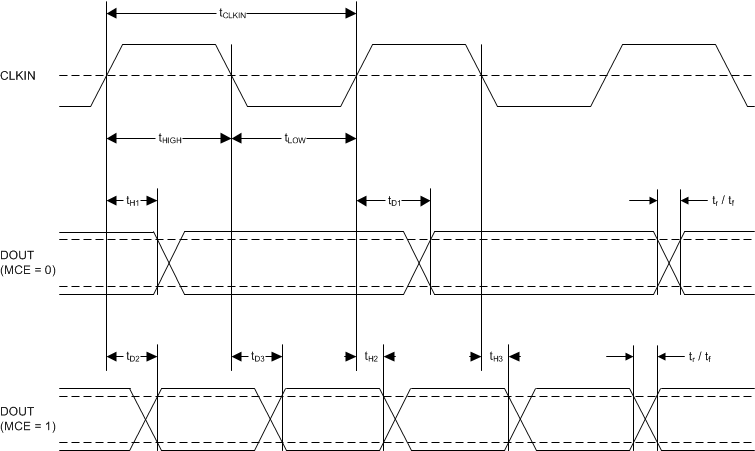SBAS837B August 2018 – April 2020 AMC1035
PRODUCTION DATA.
- 1 Features
- 2 Applications
- 3 Description
- 4 Revision History
- 5 Pin Configuration and Functions
- 6 Specifications
- 7 Detailed Description
- 8 Application and Implementation
- 9 Power Supply Recommendations
- 10Layout
- 11Device and Documentation Support
- 12Mechanical, Packaging, and Orderable Information
Package Options
Mechanical Data (Package|Pins)
- D|8
Thermal pad, mechanical data (Package|Pins)
Orderable Information
6.6 Switching Characteristics
over operating free-air temperature range (unless otherwise noted)| PARAMETER | TEST CONDITIONS | MIN | TYP | MAX | UNIT | |
|---|---|---|---|---|---|---|
| fCLKIN | CLKIN clock frequency | MCE = 0 | 9 | 20 | 21 | MHz |
| MCE = 1 | 9 | 10 | 11 | |||
| DutyCycle | CLKIN clock duty cycle(1) | 40% | 50% | 60% | ||
| tH1 | DOUT hold time after rising edge of CLKIN | MCE = 0, CLOAD = 15 pF | 6 | ns | ||
| tH2 | DOUT hold time after rising edge of CLKIN | MCE = 1, CLOAD = 15 pF | 6 | 23 | ns | |
| tH3 | DOUT hold time after falling edge of CLKIN | MCE = 1, CLOAD = 15 pF | 10 | 26 | ns | |
| tD1 | Rising edge of CLKIN to DOUT valid delay | MCE = 0, CLOAD = 15 pF | 25 | ns | ||
| tD2 | Rising edge of CLKIN to DOUT valid delay | MCE = 1, CLOAD = 15 pF | 11 | 27 | ns | |
| tD3 | Falling edge of CLKIN to DOUT valid delay | MCE = 1, CLOAD = 15 pF | 15 | 30 | ns | |
| tr | DOUT rise time | 10% to 90%, 3.0 V ≤ VDD ≤ 3.6 V, CLOAD = 15 pF | 2.5 | 5 | ns | |
| 10% to 90%, 4.5 V ≤ VDD ≤ 5.5 V, CLOAD = 15 pF | 1.5 | 3.5 | ||||
| tf | DOUT fall time | 90% to 10%, 3.0 V ≤ VDD ≤ 3.6 V, CLOAD = 15 pF | 2.5 | 5.8 | ns | |
| 90% to 10%, 4.5 V ≤ VDD ≤ 5.5 V, CLOAD = 15 pF | 1.8 | 4.4 | ||||
| tASTART | Analog startup time | VDD step to 3.0 V, 0.1% settling, CLKIN applied | 0.25 | ms | ||
(1) The duty cycle of DOUT equals the clock duty cycle of the applied CLKIN signal.
 Figure 1. Digital Interface Timing
Figure 1. Digital Interface Timing  Figure 2. Device Startup Timing
Figure 2. Device Startup Timing